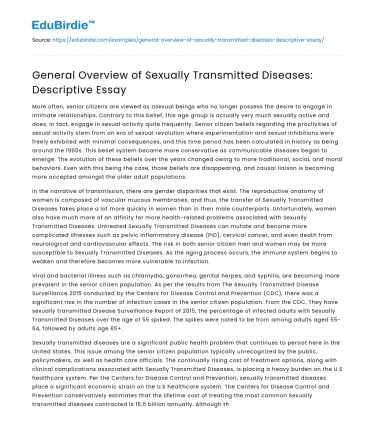More often, senior citizens are viewed as asexual beings who no longer possess the desire to engage in intimate relationships. Contrary to this belief, this age group is actually very much sexually active and does, in fact, engage in sexual activity quite frequently. Senior citizen beliefs regarding the proclivities of sexual activity stem from an era of sexual revolution where experimentation and sexual inhibitions were freely exhibited with minimal consequences, and this time period has been calculated in history as being around the 1960s. This belief system became more conservative as communicable diseases began to emerge. The evolution of these beliefs over the years changed owing to more traditional, social, and moral behaviors. Even with this being the case, those beliefs are disappearing, and causal liaison is becoming more accepted amongst the older adult populations.
In the narrative of transmission, there are gender disparities that exist. The reproductive anatomy of women is composed of vascular mucous membranes, and thus, the transfer of Sexually Transmitted Diseases takes place a lot more quickly in women than in their male counterparts. Unfortunately, women also have much more of an affinity for more health-related problems associated with Sexually Transmitted Diseases. Untreated Sexually Transmitted Diseases can mutate and become more complicated illnesses such as pelvic inflammatory disease (PID), cervical cancer, and even death from neurological and cardiovascular effects. The risk in both senior citizen men and women may be more susceptible to Sexually Transmitted Diseases. As the aging process occurs, the immune system begins to weaken and therefore becomes more vulnerable to infection.
Save your time!
We can take care of your essay
- Proper editing and formatting
- Free revision, title page, and bibliography
- Flexible prices and money-back guarantee
Viral and bacterial illness such as chlamydia, gonorrhea, genital herpes, and syphilis, are becoming more prevalent in the senior citizen population. As per the results from The Sexually Transmitted Disease Surveillance 2015 conducted by the Centers for Disease Control and Prevention (CDC), there was a significant rise in the number of infection cases in the senior citizen population. From the CDC, They have sexually transmitted Disease Surveillance Report of 2015, the percentage of infected adults with Sexually Transmitted Diseases over the age of 55 spiked. The spikes were noted to be from among adults aged 55-64, followed by adults age 65+.
Sexually transmitted diseases are a significant public health problem that continues to persist here in the United States. This issue among the senior citizen population typically unrecognized by the public, policymakers, as well as health care officials. The continually rising cost of treatment options, along with clinical complications associated with Sexually Transmitted Diseases, is placing a heavy burden on the U.S healthcare system. Per the Centers for Disease Control and Prevention, sexually transmitted diseases place a significant economic strain on the U.S healthcare system. The Centers for Disease Control and Prevention conservatively estimates that the lifetime cost of treating the most common Sexually transmitted diseases contracted is 15.6 billion annually. Although the older adult population will not pay billions of dollars for treatment, they may lack the resources and or funds to pay for medical bills or prescriptions associated with the treatment of Sexually transmitted diseases.
The older adult population is not likely to have health-seeking behaviors when it comes to Sexually transmitted diseases. The asymptomatic nature, along with the sluggish identification of signs and symptoms of Sexually transmitted diseases from older adults, can lead to a vicious cycle of transmission of the diseases from person to person. This kind of endemic in the older adult population can lead to epidemic levels causing concern for the public. This issue should be addressed on local, state, and federal levels.






 Stuck on your essay?
Stuck on your essay?

